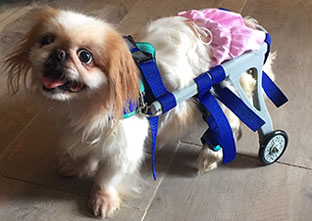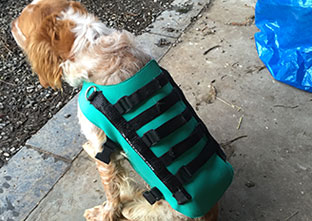Plastics take the hair of the dog

You revolutionised the wheelchair for disabled animals. How did you improve a piece of equipment that has been around for decades ?
Above all, I improved its ergonomics. The models that were available at the time were often extremely large and cumbersome for animal and owner alike. I first set out to find a way to make them foldable. This was crucial to enable it to be easily stored, and to enable the animal to easily sit and lie down. I spent a long time studying animal morphology in order to find the best place to put the joint. Creating a satisfactory prototype required a lot of patience and perseverance.

How did you come up with this idea?
 I am a physiotherapist and I have long been fascinated by animals. A few years ago, one of my patients told me about his dog whose rear legs were paralysed. He didn't know how to help his pet and was not enthused by the models of wheelchairs available at the time. I asked him to bring in his dog and, as a physiotherapist, I soon noticed that the wheelchairs were not adapted to the animal's biomechanics. Worse yet, they could accentuate the disability and lead to bigger back problems as they put too much stress on the spine. One thing led to another, I got caught up in my investigations and, after designing a model that I felt was satisfactory, I decided to create a company through which to sell it.
I am a physiotherapist and I have long been fascinated by animals. A few years ago, one of my patients told me about his dog whose rear legs were paralysed. He didn't know how to help his pet and was not enthused by the models of wheelchairs available at the time. I asked him to bring in his dog and, as a physiotherapist, I soon noticed that the wheelchairs were not adapted to the animal's biomechanics. Worse yet, they could accentuate the disability and lead to bigger back problems as they put too much stress on the spine. One thing led to another, I got caught up in my investigations and, after designing a model that I felt was satisfactory, I decided to create a company through which to sell it.
How did you manufacture the first models?
 They were very much home-made! The frame was made from aluminium, a fairly flexible, resistant and light material. The wheelchairs were almost custom-made; I contacted a small manufacturer who had machines able to cut and bend the aluminium tubes. The corset was and still is made from neoprene, a flexible material that is easy to cut. However, it had to be fitted with polypropylene straps sewn onto the neoprene; I delegated this task to a shoemaker. The wheels come from scooters like those that can be found in specialised stores. Each wheelchair is almost unique as it is adapted to the dog's morphology. I believe that the most important thing is maintaining the dog in a natural position taking into account the biomechanics of its back. In addition, the wheelchair enables any disabled animal, even those that are temporarily disabled, following an operation or an accident, to have an alternative to total immobilisation or even euthanasia.
They were very much home-made! The frame was made from aluminium, a fairly flexible, resistant and light material. The wheelchairs were almost custom-made; I contacted a small manufacturer who had machines able to cut and bend the aluminium tubes. The corset was and still is made from neoprene, a flexible material that is easy to cut. However, it had to be fitted with polypropylene straps sewn onto the neoprene; I delegated this task to a shoemaker. The wheels come from scooters like those that can be found in specialised stores. Each wheelchair is almost unique as it is adapted to the dog's morphology. I believe that the most important thing is maintaining the dog in a natural position taking into account the biomechanics of its back. In addition, the wheelchair enables any disabled animal, even those that are temporarily disabled, following an operation or an accident, to have an alternative to total immobilisation or even euthanasia.
Have your industrial processes changed over time?
Yes, but the next major improvement will take place in 2017 as I intend to increasingly make use of 3D printing technology. I will therefore be abandoning aluminium and replacing it with ABS which is even lighter for the small wheelchairs. It is also a very solid material which has a magnificent finish when it comes out of the printer, and it is available in many different colours. The wheelchairs will be able to be further personalised. This is no small thing as many owners of disabled dogs do not like the looks they get from other people and often fear being mocked when they are out walking their beloved pet.

So the changeover to ABS is mainly down to aesthetic reasons?
 No. Although it is a consideration, it is not the main factor. The 3D printer enables wheelchairs to be made for very small animals such as rats and ferrets. This type of animal is increasingly found as a pet in homes, and they can also fall prey to accidents. There is a demand, and there are currently no solutions available to help these small animals. Even partial paralysis can be a death sentence for them. I am currently following training on 3D modelling software in order to be operational as soon as possible. However, I have already made a few 3D-printed wheelchairs. It will revolutionise my small company, and I know that many people are looking forward to seeing the results. The problem of the wheels still needs to be resolved, but some models currently available on the market are perfectly adequate.
No. Although it is a consideration, it is not the main factor. The 3D printer enables wheelchairs to be made for very small animals such as rats and ferrets. This type of animal is increasingly found as a pet in homes, and they can also fall prey to accidents. There is a demand, and there are currently no solutions available to help these small animals. Even partial paralysis can be a death sentence for them. I am currently following training on 3D modelling software in order to be operational as soon as possible. However, I have already made a few 3D-printed wheelchairs. It will revolutionise my small company, and I know that many people are looking forward to seeing the results. The problem of the wheels still needs to be resolved, but some models currently available on the market are perfectly adequate.
You also manufacture corsets. What are they used for?
 Remember that I was trained as a physiotherapist. I am therefore striving to adapt the solutions that exist for humans to the animal kingdom. Although our furry friends are less sensitive to pain than we are, they do feel it and it can be a real handicap. I therefore came up with the idea of creating a corset for animals with a fracture of the vertebrae or an operable or non-operable herniated disc. No such solutions were available on the market and vets, let's be honest, are not physiotherapists. I opted to use neoprene for these harnesses. It is a flexible, waterproof and very solid material that protects the skin against friction. The corsets are fitted with adjustable straps for excellent support. Once they have been clipped together, the straps rest on the neoprene whose flexibility ensures an even distribution of the resulting pressure. The animal does not feel hindered by the corset and can continue to lead an almost normal life until it has healed.
Remember that I was trained as a physiotherapist. I am therefore striving to adapt the solutions that exist for humans to the animal kingdom. Although our furry friends are less sensitive to pain than we are, they do feel it and it can be a real handicap. I therefore came up with the idea of creating a corset for animals with a fracture of the vertebrae or an operable or non-operable herniated disc. No such solutions were available on the market and vets, let's be honest, are not physiotherapists. I opted to use neoprene for these harnesses. It is a flexible, waterproof and very solid material that protects the skin against friction. The corsets are fitted with adjustable straps for excellent support. Once they have been clipped together, the straps rest on the neoprene whose flexibility ensures an even distribution of the resulting pressure. The animal does not feel hindered by the corset and can continue to lead an almost normal life until it has healed.
Neoprene is also used in the leg protectors that we sell to limit the damage caused by friction with the ground. Many hours of study and research were also required to develop them as they replace the leg protectors currently available on the market. They are intended for partially or entirely paralysed animals whose legs tend to drag on the ground and get injured as a result. Thanks to my solution, because the pad of the paw is not protected, partially paralysed animals are able to retain contact with the ground and are less disoriented. This equipment may seem pretty obvious but it is the result of a very long observation of animal behaviour.

You also sell orthotics
 I do, and they are a great help for animals who have suffered nerve damage as a result of an accident. They maintain the limb in a correct position that promotes healing. For the time being, I am using the same technique as that used for humans. It uses a polymer that is thermoformed at low temperature which is then adjusted to the animal's morphology through moulding. However, although we are the only ones to be using this technique, it can still be improved. I am seriously considering investing in a 3D scanner so that I can have a perfect image of the limb to be fitted. It would be extremely useful for large animals, such as large dogs.
I do, and they are a great help for animals who have suffered nerve damage as a result of an accident. They maintain the limb in a correct position that promotes healing. For the time being, I am using the same technique as that used for humans. It uses a polymer that is thermoformed at low temperature which is then adjusted to the animal's morphology through moulding. However, although we are the only ones to be using this technique, it can still be improved. I am seriously considering investing in a 3D scanner so that I can have a perfect image of the limb to be fitted. It would be extremely useful for large animals, such as large dogs.
And prostheses?
 This is also an avenue for development that I am considering for my company, particularly in light of the fact that 3D printers can be a real asset. I recently contacted a prosthesist and we are currently discussing plans to adapt procedures for humans to the animal kingdom. That is our philosophy!
This is also an avenue for development that I am considering for my company, particularly in light of the fact that 3D printers can be a real asset. I recently contacted a prosthesist and we are currently discussing plans to adapt procedures for humans to the animal kingdom. That is our philosophy!





